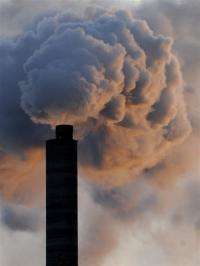Heavy smoke billows from a factory in Pietarsaari, Finland. International experts are warning that potentially lethal air pollution has boomed in fast-growing big cities in Asia and South America in recent decades.
International experts are warning that potentially lethal air pollution has boomed in fast-growing big cities in Asia and South America in recent decades.
While Europe has managed to drastically cut some, but not all, of the most noxious pollutants over the past 20 years, emerging nations experienced the opposite trend with their fast economic growth, scientists at the UN's meteorological agency said.
Their comments came ahead of World Meteorological Day on Monday, which this year has the theme "The Air We Breathe".
The World Health Organization estimates that about two million people die prematurely every year as a result of air pollution, while many more suffer from breathing ailments, heart disease, lung infections and even cancer.
Fine particles or microscopic dust from coal or wood fires and unfiltered diesel engines are rated as one of the most lethal forms or air pollution caused by industry, transport, household heating, cooking and ageing coal or oil-fired power stations.
In 2005, the WHO estimated that deaths rates in cities with higher particle pollution were 15 to 20 percent above those found in cleaner cities.
"Particulate matter is of great concern in cities," said Liisa Jalkanen, atmospheric environment research chief at the World Meteorological Organisation.
"In Asia many cities such as Karachi, New Delhi, Kathmandu, Dacca, Shanghai, Beijing, and Mumbai they exceed all the limits."
"Also several cities in South America such as Lima, Santiago, Bogota. The worst city in Africa is Cairo," she told journalists.
Half of the world?s population now live in urban areas, and the proportion is expected to grow to two-thirds by 2030, according to the United Nations.
The WMO says more resources are needed for a global air monitoring network it runs with national weather offices.
Len Barrie, director of WMO research, said restrictions set up in Europe after concern about acid rain emerged in the 1980s have cut concentrations of another pollutant, sulphur dioxide, there "by a factor of 20".
"In other areas where economic growth has leapt forward, such as Asia, China, India, the opposite is true," he added. In North America levels were largely kept in check.
But Barrie told AFP that such pollution in China appeared to be reaching its peak.
"There?s a real awakening in China on the economic benefits of reducing air pollution," he added.
Attempts are being made to bring developing and emerging nations, as well as the United States, into a new global warming pact in Copenhagen in December.
While such curbs on carbon emissions can have a substantial impact on overall air pollution, they may not tackle it completely.
Levels of another harmful pollutant, nitrogen dioxide, from vehicle traffic have not decreased in Europe by as much as the WMO expected, while the impact of weather patterns on pollution is also a concern.
(c) 2009 AFP


















